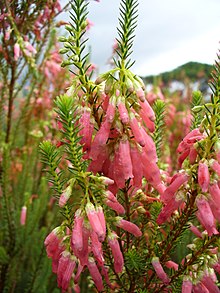Erica mammosa: Difference between revisions
Content deleted Content added
Darorcilmir (talk | contribs) added text, cit., links |
Darorcilmir (talk | contribs) No edit summary |
||
| Line 18: | Line 18: | ||
It is a shrub, growing to {{convert| 2.5|m|ft|abbr=on}} tall and broad, that produces masses of flowers in a range of colours from light-pink to orange to bright red. |
It is a shrub, growing to {{convert| 2.5|m|ft|abbr=on}} tall and broad, that produces masses of flowers in a range of colours from light-pink to orange to bright red. |
||
The species name ''"mammosa"'' means "with breasts" and refers to the udder-like shape of the flowers. |
|||
The species name ''"mammosa"'' means "with breasts" and refers to the udder-like tubular shape of the flowers.<ref name=RHSLG>{{cite book |last=Harrison |first=Lorraine |title=RHS Latin for Gardeners |year=2012 |publisher=Mitchell Beazley |location=United Kingdom |isbn=184533731X }}</ref> |
|||
This plant is increasingly popular as an ornamental garden subject.<ref>http://www.plantzafrica.com/plantefg/ericamammosa.htm</ref> |
This plant is increasingly popular as an ornamental garden subject.<ref>http://www.plantzafrica.com/plantefg/ericamammosa.htm</ref> |
||
Revision as of 23:37, 17 February 2018
| Erica mammosa | |
|---|---|

| |
| Scientific classification | |
| Kingdom: | |
| (unranked): | |
| (unranked): | |
| (unranked): | |
| Order: | |
| Family: | |
| Genus: | |
| Species: | E. mammosa
|
| Binomial name | |
| Erica mammosa | |
Erica mammosa (the nine-pin heath) is a species of flowering plant in the family Ericaceae, that was naturally restricted to the south-western corner of the Western Cape, South Africa.
It is a shrub, growing to 2.5 m (8.2 ft) tall and broad, that produces masses of flowers in a range of colours from light-pink to orange to bright red.
The species name "mammosa" means "with breasts" and refers to the udder-like tubular shape of the flowers.[2]
This plant is increasingly popular as an ornamental garden subject.[3] In the UK it has gained the Royal Horticultural Society’s Award of Garden Merit.[4][5]
Gallery
Wikimedia Commons has media related to Erica mammosa.
See also
References
- ^ "Erica mammosa". The Plant List. Retrieved 17 February 2018.
- ^ Harrison, Lorraine (2012). RHS Latin for Gardeners. United Kingdom: Mitchell Beazley. ISBN 184533731X.
- ^ http://www.plantzafrica.com/plantefg/ericamammosa.htm
- ^ "RHS Plantfinder - Erica mammosa". Retrieved 17 February 2018.
- ^ "AGM Plants - Ornamental" (PDF). Royal Horticultural Society. July 2017. p. 36. Retrieved 16 February 2018.


